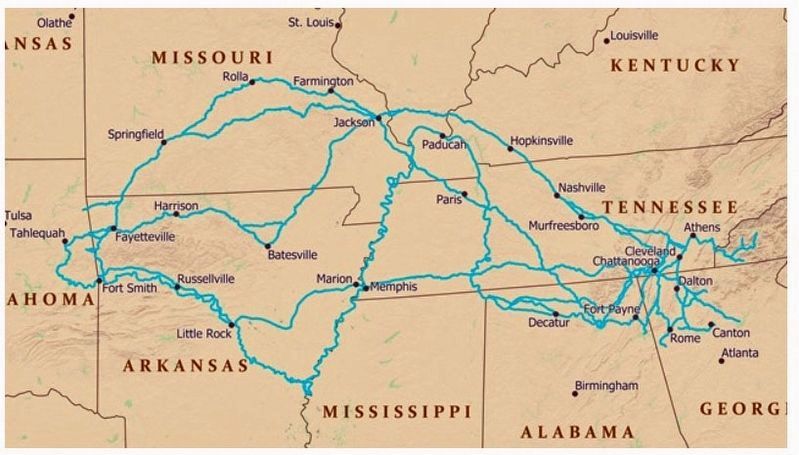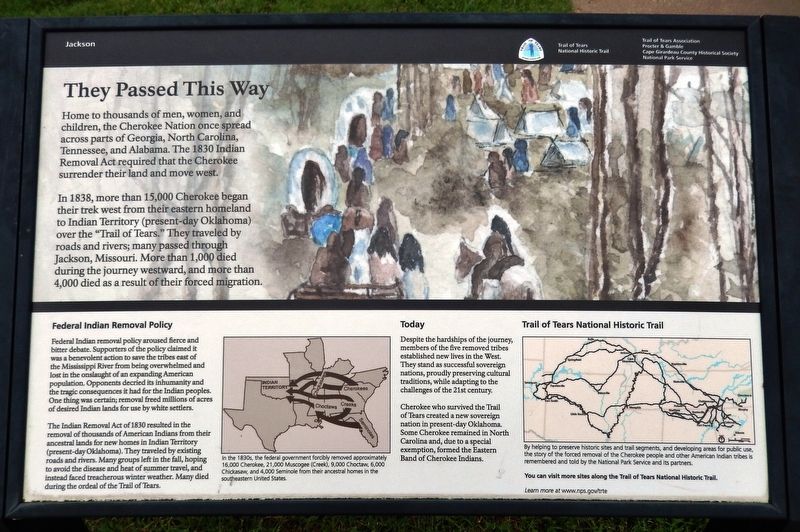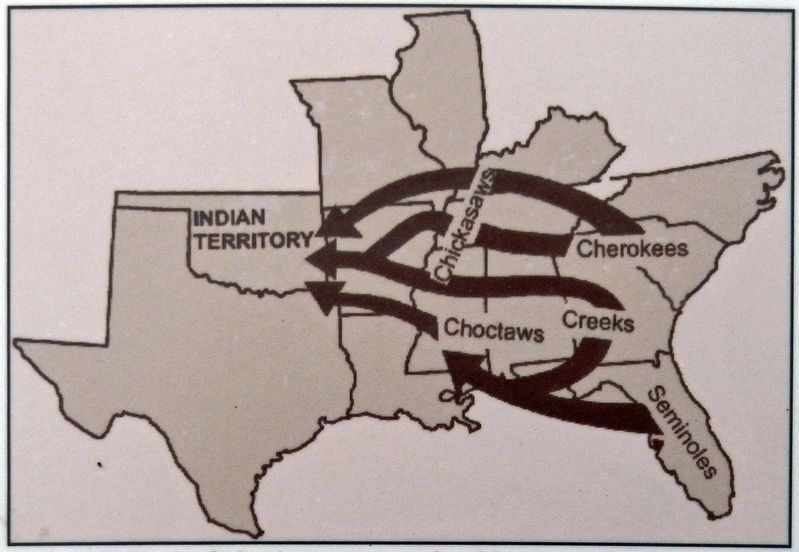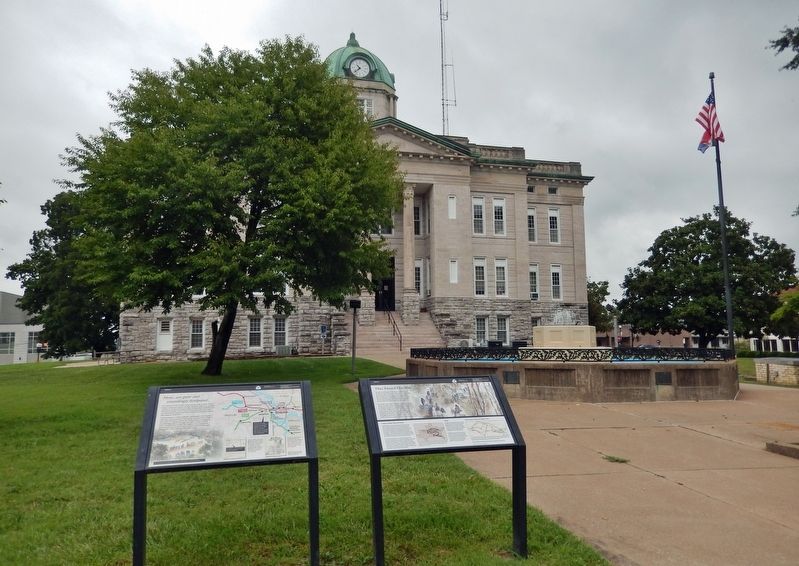Byrd Township in Jackson in Cape Girardeau County, Missouri — The American Midwest (Upper Plains)
They Passed This Way
— Trail of Tears National Historic Trail —
Home to thousands of men, women, and children, the Cherokee Nation once spread across parts of Georgia, North Carolina, Tennessee, and Alabama. The 1830 Indian Removal Act required that the Cherokee surrender their land and move west.
In 1838, more than 15,000 Cherokee began their trek west from their eastern homeland to Indian Territory (present-day Oklahoma) over the “Trail of Tears.” They traveled by roads and rivers; many passed through Jackson, Missouri. More than 1,000 died during the journey westward, and more than 4,000 died as a result of their forced migration.
Federal Indian Removal Policy
Federal Indian removal policy aroused fierce and bitter debate. Supporters of the policy claimed it was a benevolent action to save the tribes east of the Mississippi River from being overwhelmed and lost in the onslaught of an expanding American population. Opponents decried its inhumanity and the tragic consequences it had for the Indian peoples. One thing was certain: removal freed millions of acres of desired Indian lands for use by white settlers.
The Indian Removal Act of 1830 resulted in the removal of thousands of American Indians from their ancestral lands for new homes in Indian Territory (present-day Oklahoma). They traveled by existing roads and rivers. Many groups left in the fall, hoping to avoid the disease and heat of summer travel, and instead faced treacherous winter weather. Many died during the ordeal of the Trail of Tears.
Today
Despite the hardships of the journey, members of the five removed tribes established new lives in the West. They stand as successful sovereign nations, proudly preserving cultural traditions, while adapting to the challenges of the 21st century.
Cherokee who survived the Trail of Tears created a new sovereign nation in present-day Oklahoma. Some Cherokee remained in North Carolina and, due to a special exemption, formed the Eastern Band of Cherokee Indians.
You can visit more sites along the Trail of Tears National Historic Trail.
Learn more at: www.nps.gov/trte
Erected by Trail of Tears Association; Procter & Gamble; Cape Girardeau County Historical Society; and National Park Service.
Topics and series. This historical marker is listed in these topic lists: Native Americans • Roads & Vehicles. In addition, it is included in the Trail of Tears series list. A significant historical year for this entry is 1838.
Location. 37° 22.961′ N, 89° 40.064′ W. Marker is in Jackson, Missouri, in Cape Girardeau County. It is in Byrd Township. Marker is at the intersection of West Main Street and South
High Street, on the left when traveling east on West Main Street. The marker is located beside the sidewalk on the south side of the Cape Girardeau County Courthouse. Touch for map. Marker is at or near this postal address: 100 Court Street, Jackson MO 63755, United States of America. Touch for directions.
Other nearby markers. At least 8 other markers are within 10 miles of this marker, measured as the crow flies. Most...are poor and exceedingly dissipated. (here, next to this marker); Pfc. Richard Wilson (approx. 5.1 miles away); Cape Girardeau Freedom Rock Veterans Memorial (approx. 5.1 miles away); Cape Girardeau (approx. 5.1 miles away); The History of the 140th Infantry Regiment (approx. 5.1 miles away); Bollinger Mill/Burfordville Covered Bridge (approx. 7˝ miles away); George & Fred Naeter (approx. 7.8 miles away); Old Lorimier Cemetery (approx. 9˝ miles away).
Related markers. Click here for a list of markers that are related to this marker.
Also see . . .
1. Trail of Tears National Historic Trail (National Park Service). Excerpt:
In May 1838, the Cherokee removal process began. U.S. Army troops, along with various state militia, moved into the tribe’s homelands and forcibly evicted more than 16,000 Cherokee Indian people from their homelands in Tennessee, Alabama, North Carolina, and Georgia. They were first sent to so-called “round up(Submitted on November 26, 2023, by Cosmos Mariner of Cape Canaveral, Florida.)camps,” and soon afterward to one of three emigration camps. Once there, the U.S. Army gave orders to move the Cherokee west. The impact of the resulting Cherokee “Trail of Tears” was devastating. More than a thousand Cherokee – particularly the old, the young, and the infirm – died during their trip west, hundreds more deserted from the detachments, and an unknown number – perhaps several thousand – perished from the consequences of the forced migration. The tragic relocation was completed by the end of March 1839, and resettlement of tribal members in Oklahoma began soon afterward. The Cherokee, in the years that followed, struggled to reassert themselves in the new, unfamiliar land. 3. Marker detail: Trail of Tears National Historic TrailBy helping to preserve historic sites and trail segments, and developing areas for public use, the story of the forced removal of the Cherokee people and other American Indian tribes is remembered and told by the National Park Service and its partners.
3. Marker detail: Trail of Tears National Historic TrailBy helping to preserve historic sites and trail segments, and developing areas for public use, the story of the forced removal of the Cherokee people and other American Indian tribes is remembered and told by the National Park Service and its partners.
2. Indian Removal Act (Wikipedia). Excerpt:
The Indian Removal Act was signed into law on May 28, 1830, by United States President Andrew Jackson. The law, as described by Congress, provided "for an exchange of lands with the Native Americans residing in any of the states or territories, and for their removal west of the river Mississippi." During the presidency of Jackson (1829–1837) and his successor Martin Van Buren (1837–1841) more than 60,000 Native Americans from at least 18 tribes were forced to move west of the Mississippi River where they were allocated new lands as part of an ethnic cleansing.(Submitted on November 26, 2023, by Cosmos Mariner of Cape Canaveral, Florida.)
Credits. This page was last revised on November 26, 2023. It was originally submitted on November 26, 2023, by Cosmos Mariner of Cape Canaveral, Florida. This page has been viewed 61 times since then and 23 times this year. Photos: 1, 2, 3, 4. submitted on November 26, 2023, by Cosmos Mariner of Cape Canaveral, Florida.


